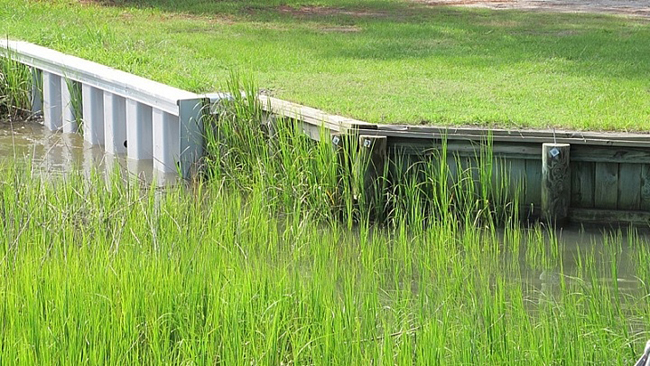Note: UGA Skidaway Institute director Clark Alexander is a co-author on the project described in this article.
By Julie Cohen
For nearly a century, the O’Shaughnessy seawall has held back the sand and seas of San Francisco’s Ocean Beach. At work even longer: the Galveston seawall, built after America’s deadliest hurricane in 1900 killed thousands in Texas. And visitors to the salt marshes behind Georgia’s barrier islands commonly encounter bulkheads, retaining walls built to reduce erosion.
These are just a few examples of how America’s coasts—particularly those with large urban populations—have been armored with man-made structures. The type of armoring structure varies widely with the environmental setting, ranging from massive seawalls and revetments along the wave-exposed open coast to smaller bulkheads and manmade oyster reefs in tidal marshes and estuaries.
These structures essentially draw a line in the sand that constrains the ability of the shoreline to respond to changes in sea level and other dynamic coastal processes. While the resulting ecological effects have been studied more in recent years, the research largely has been conducted in specific settings, making it difficult to generalize across ecosystems and structure types.
A new study by a team including UGA professor of marine science Merryl Alber and colleagues from three coastal sites in the National Science Foundation’s Long Term Ecological Research (LTER) network provides a key first step toward generalizing ecological responses to armoring across the wide diversity of coastal settings where these structures are used. The team’s findings appear online and will be published this fall in a special issue of the journal Estuaries and Coasts.
Scientists from three very different LTER programs were already working on the ecological impact of coastal armoring at their respective sites. The Georgia Coastal Ecosystems (GCE) project conducted studies of the effects of small-scale armoring in salt marshes. At the Santa Barbara Coastal LTER, studies of the effects of seawalls on open coast beaches had revealed significant ecological impacts extending up to birds. Studies at the Virginia Coast Reserve LTER focused on the use of constructed oyster reefs and living shorelines as coastal protection strategies.
“What was novel about this cross-site collaboration was putting these site-specific studies into perspective by making comparisons across a broad range of habitats,” said Alber, co-author and principal investigator of the GCE LTER project.
The collaborative study synthesizes existing literature examining different types of armoring across a variety of soft sediment ecosystems. The scientists used that data to evaluate a new conceptual model created during two LTER cross-site workshops.
“Our model uses two simple axes: the environmental setting of the armoring structure in terms of hydrodynamic energy, like wave and tide regimes, and the degree to which a structure was built to slow water movement or actually stop it from getting through,” said lead author Jenifer Dugan, a research biologist at the University of California Santa Barbara (UCSB) Marine Science Institute. “We then reviewed the results from a wide spectrum of studies in the literature and used that information to evaluate how well our conceptual model could predict the ecological effects of armoring.”
Of the 88 studies reviewed by the researchers, the majority had been conducted in very low-energy environments—predominantly salt marshes and tidal creeks but also mangroves—and about one-quarter in medium-energy systems, such as harbors, river mouths and estuaries. Only 15 percent focused on high-energy environments—mostly open coast sandy beaches.
Across the six categories of ecological responses examined, the results of existing literature focused largely on changes in habitat and species distribution, leaving questions about how shoreline armoring affects other key ecological responses such as biodiversity and alteration of habitat. However, negative effects of shoreline armoring were reported in all six categories.
“We found that structures designed to stop water had more negative ecological effects than those designed to slow it down, which is what we had predicted,” Alber said. “We also found some evidence that structures in higher energy environments (e.g., open beaches) have greater effects, although that requires additional research.”
As sea level continues to rise, existing coastal armoring structures are likely to experience greater hydrodynamic energy and magnified ecological impacts, according to Dugan.
“Understanding how these ecological responses vary with hydrodynamic energy and their effect on water flow could help people design and install armoring structures that could have less ecological impact,” she said.
Other co-authors are Clark Alexander, James Byers, Alyssa Gehman and Natalie McLenaghan, all of the University of Georgia; Kyle Emery, a doctoral student at UCSB; and Sarah E. Sojka of Randolph College in Lynchburg, Virginia.


